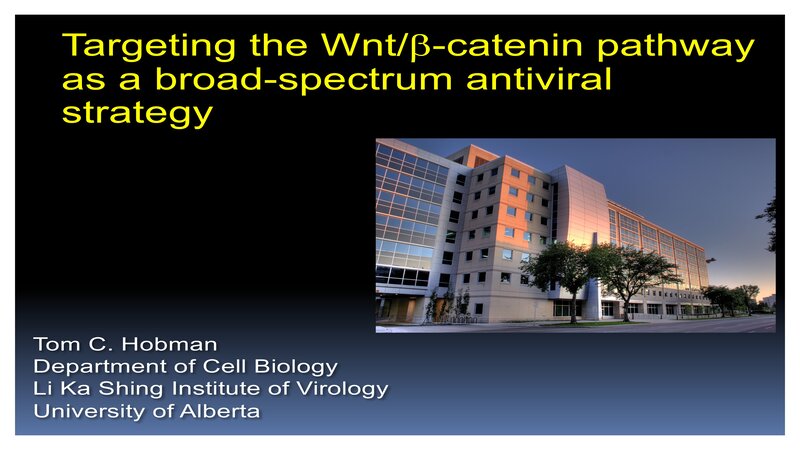
TONIX PHARMACEUTICALS HOLDING CORP. FORM 8-K
Exhibit 99.02

Targeting the Wnt/b-catenin pathway as a broad-spectrum antiviral strategy Tom C. Hobman Department of Cell Biology Li Ka Shing Institute of Virology University of Alberta
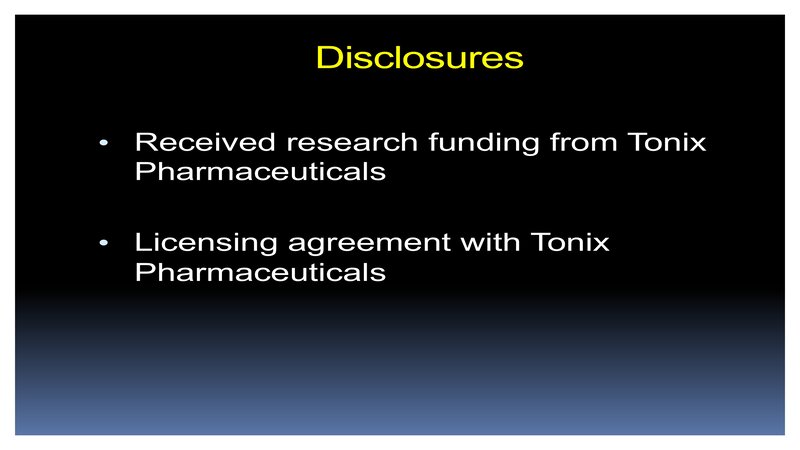
Disclosures • Received research funding from Tonix Pharmaceuticals • Licensing agreement with Tonix Pharmaceuticals
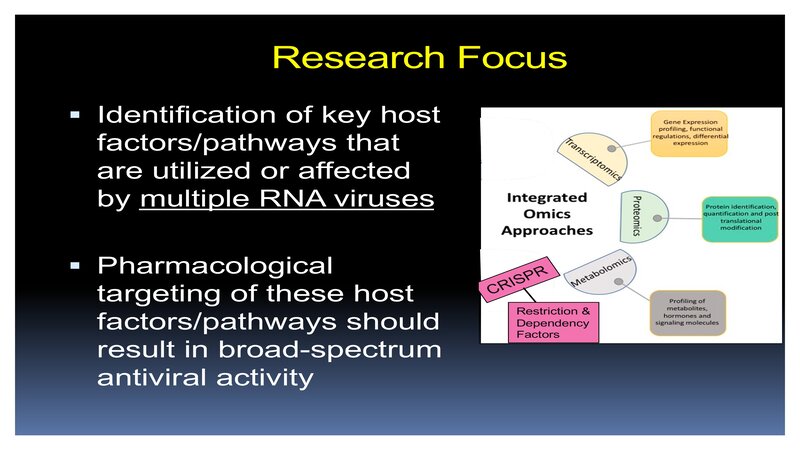
Researchapproaches Focus Experimental § •Identification Flaviviruses of key host factors/pathways that •are Alphaviruses utilized or affected by multiple RNA viruses • HIV § •Pharmacological Coronaviruses • PR S I CR targeting of these host Restriction & Dependency factors/pathways should Factors result in broad-spectrum Determine cellular pathways are perturbed or activated antiviralwhich activity • Test effects of pathway agonists/inhibitors on virus replication

“For the present pandemic response, and for future pandemics …. the scientific community must be ready with an arsenal of easily self-administered drugs that can be tested in rapid, efficient clinical trials immediately after the causative viral agent is identified.” White et al, 2021 Host-targeted antivirals to be part of this arsenal?
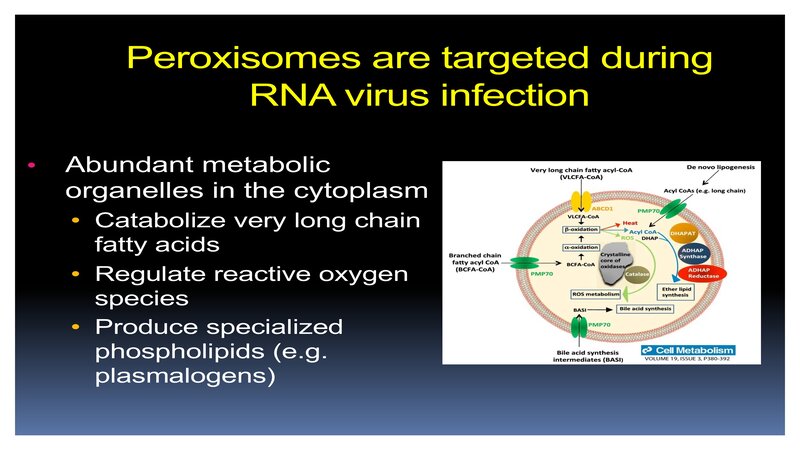
Peroxisomes are targeted during RNA virus infection • Abundant metabolic organelles in the cytoplasm • Catabolize very long chain fatty acids • Regulate reactive oxygen species • Produce specialized phospholipids (e.g. plasmalogens)
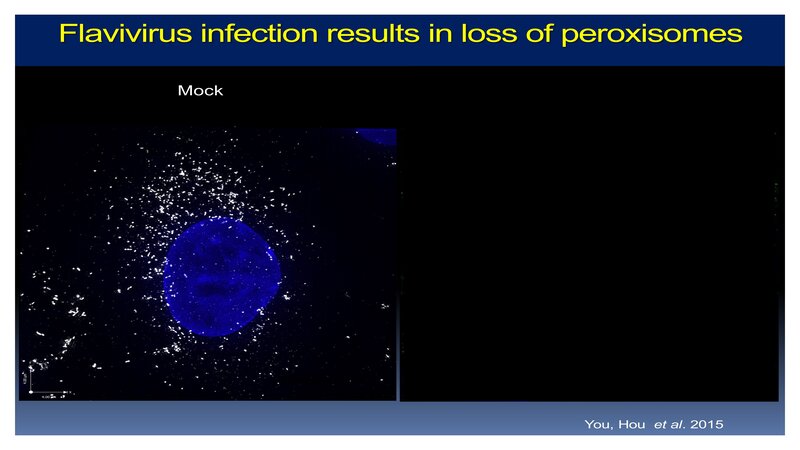
Flavivirus infection results in loss of peroxisomes Mock WNV Mock WNV Peroxisome aNS2B-3 Peroxisome You, Hou et al. 2015
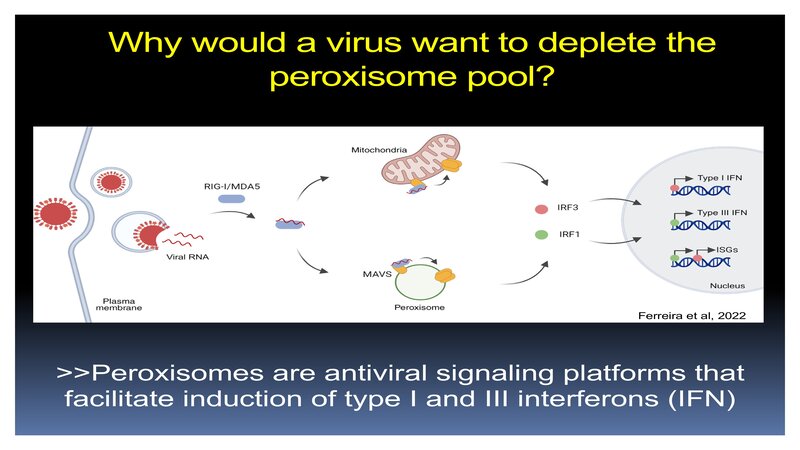
Why would a virus want to deplete the Trends in Cell Biology peroxisome pool? Ferreira et al, 2022 Trends in Cell Biology Figure 1. Mitochondrial antiviral signaling (MAVS) protein-dependent antiviral signaling. Upon virus entry, viral RNA is released into the cytosol where it is recognized by retinoic acid-inducible gene I (RIG-I) or melanoma differentiation-associated protein 5 (MDA5). This recognition allows the activation of MAVS at both mitochondria and peroxisomes. MAVS then undergoes a conformational change that allows its oligomerization, which is essential for the activation of a signaling cascade that activates the transcription factors interferon regulatory factors IRF1 and IRF3. Translocation of IRF1 and IRF3 to the nucleus promotes the expression of type I and type III interferons (IFNs) and IFN-stimulated genes (ISGs). Figure prepared using BioRender.com. >>Peroxisomes are antiviral signaling platforms that facilitate induction of type I and III interferons (IFN) inhibits downstream signaling [35] (Figure 2). Although vMIA also inhibits mitochondria-dependent MAVS signaling, HCMV seems to have developed distinct mechanisms to interfere with antiviral signaling at both organelles. In fact, although vMIA inhibits mitochondria-dependent signaling
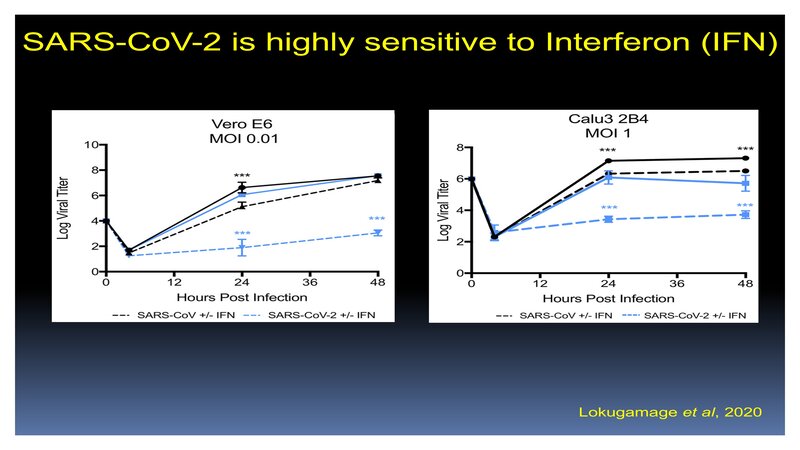
SARS-CoV-2 is highly sensitive to Interferon (IFN) SARS-CoV-2 Is Sensitive to Type I IFN Pretreatment Lokugamage et al. FIG 1 SARS-CoV-2 is sensitive to type I IFN pretreatment. (A) Vero E6 cells were treated with 1,000 U recombinant type I (hashed line) IFN or mock (solid line) for 18 h prior to infection. The cells were subseque infected with either SARS-CoV wild type (WT; black) or SARS-CoV-2 (blue) at an MOI of 0.01, as described in the Each point on the line graph represents the group mean (n # 3). All error bars represent the standard deviat (SD). A two-tailed Student t test was used to determine P values (***, P ! 0.001). (B) Vero E6 cell protein lysates Lokugamage et al, 2020 IFN-I-treated and untreated cells were probed at 48 h postinfection by Western blotting for phosphorylated ST (Y701), STAT1, IFITM1, SARS spike, and actin.
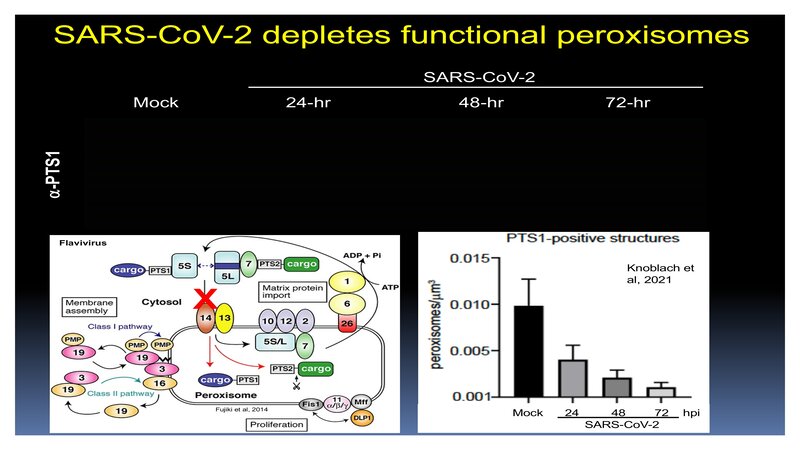
SARS-CoV-2 depletes functional peroxisomes SARS-CoV-2 24-hr 48-hr 72-hr a-PTS1 Mock Flavivirus Knoblach et al, 2021 X Fujiki et al, 2014 Mock 24 48 72 SARS-CoV-2 hpi
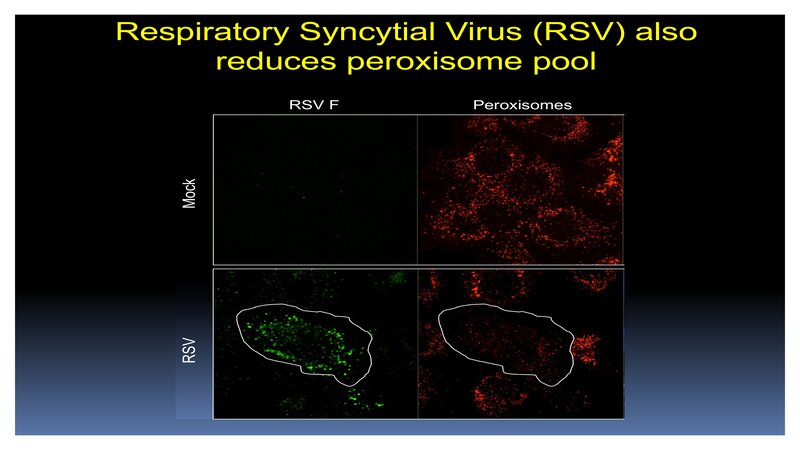
Respiratory Syncytial Virus (RSV) also Respiratory syncytial virus infection depletes reduces peroxisome pool peroxisomes too RSV Mock RSV F Peroxisomes Merge
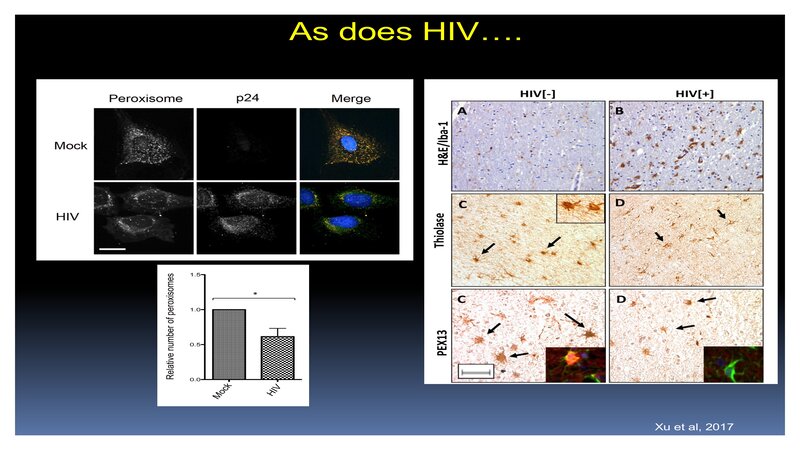
As does HIV…. Xu et al, 2017
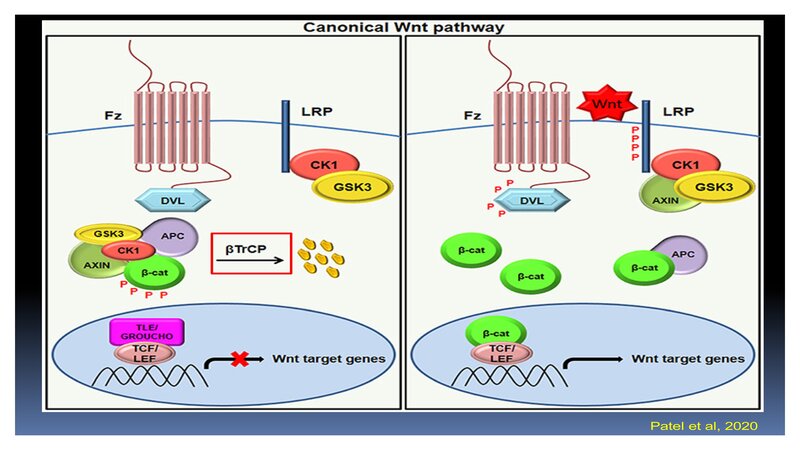
Patel et al, 2020
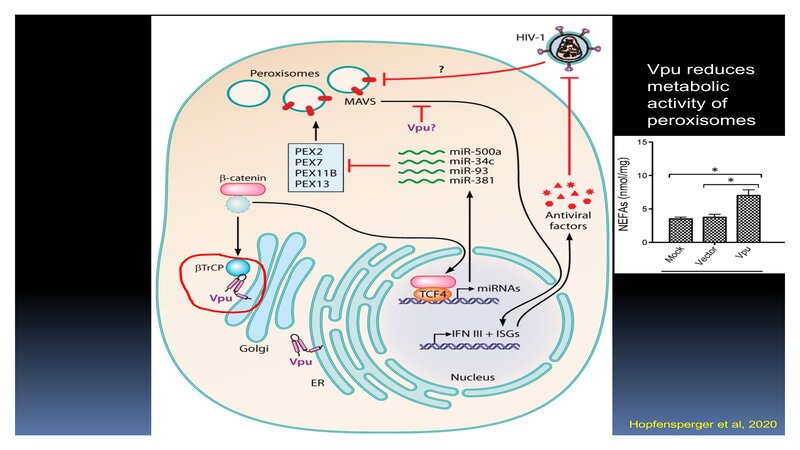
HIV-1 Vpu suppresses peroxisome biogenesis Vpu reduces metabolic activity of peroxisomes RESEARCH ARTICLE Host-Microbe Biology crossm RESEARCH ARTICLE Host-Microbe Biology crossm The HIV-1 Accessory Protein Vpu Downregulates Peroxisome Biogenesis The HIV-1 Accessory Protein Peroxisome Zaikun Xu, Robert Lodge, Christopher Power, Eric A.Vpu Cohen, Downregulates Tom C. Hobman Biogenesis Department of Cell Biology, University of Alberta, Edmonton, Alberta, Canada a b c,d,f,g b,h a,d,e,f a Laboratory of Human Retrovirology, Institut de Recherches Cliniques de Montréal, Montréal, Quebec, Canada b b c,d,f,g Eric A. Cohen,b,h Tom C. Hobmana,d,e,f Zaikun Xu,ofa Medicine, Robert Lodge, Power, Department University ofChristopher Alberta, Edmonton, Alberta, Canada c Department of Medical Microbiology and Immunology, University of Alberta, Edmonton, Alberta, Canada Department of Cell Biology, University of Alberta, Edmonton, Alberta, Canada Li Ka Shing Institute of Virology, University of Alberta, Edmonton, Alberta, Canada bLaboratory of Human Retrovirology, Institut de Recherches Cliniques de Montréal, Montréal, Quebec, Canada fWomen & Children's Health Research Institute, University of Alberta, Edmonton, Alberta, Canada d a e Department Medicine, of Alberta, Edmonton, Alberta, Canada Alberta, Canada Neuroscienceofand MentalUniversity Health Institute, University of Alberta, Edmonton, Department of of Microbiology, Medical Microbiology and Immunology, University ofUniversité Alberta, Edmonton, Alberta, Canada Department Infectious Diseases and Immunology, de Montréal, Montréal, Quebec, Canada c g d h Li Ka Shing Institute of Virology, University of Alberta, Edmonton, Alberta, Canada e Women & Children's Healthimmunodeficiency Research Institute, University Alberta, Edmonton, Alberta, Canada ABSTRACT Human virus oftype 1 (HIV-1) establishes lifelong infecgNeuroscience and Mental Health Institute, University of Alberta, Edmonton, Alberta, Canada tions in humans, a process that relies on its ability to thwart innate and adaptive imf Department of Microbiology, Infectious Diseases and Université de Montréal, Montréal, mune defenses of the host. Recently, weImmunology, reported that HIV-1 infection resultsQuebec, in a Canada dramatic reduction of the cellular peroxisome pool. Peroxisomes are metabolic orABSTRACT immunodeficiency type 1 in(HIV-1) establishes lifelong infecganelles thatHuman also function as signalingvirus platforms the innate immune response. tions in humans, a process that relies on its ability to thwart innate and adaptive Here, we show that the HIV-1 accessory protein Vpu is necessary and sufficient imfor mune defensesofofcellular the host. Recently, during we reported that Vpu HIV-1induces infection in a the depletion peroxisomes infection. the results expression dramatic reduction that of thetarget cellular peroxisome pool. Peroxisomes orof four microRNAs mRNAs encoding proteins requiredareformetabolic peroxisome ganelles that also function as signaling platforms in the innate immune response. formation and metabolic function. The ability of Vpu to downregulate peroxisomes Here, we show the HIV-1upon accessory protein Vpu issignaling necessary and sufficient for was found to bethat dependent the Wnt/ !-catenin pathway. Given the the depletion cellular peroxisomes during infection. the expression importance of of peroxisomes in innate immune signaling Vpu and induces central nervous system :d0ea:d18c:d071:5b5b. 1:5b5b. h Hopfensperger et al, 2020
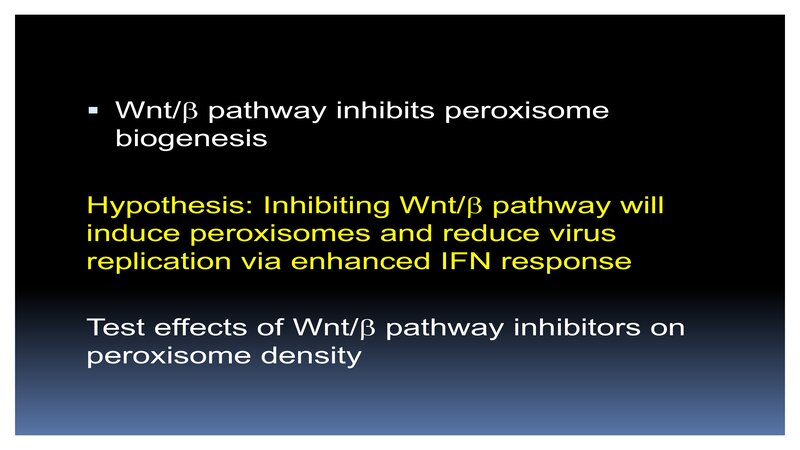
§ Wnt/b pathway inhibits peroxisome biogenesis Hypothesis: Inhibiting Wnt/b pathway will induce peroxisomes and reduce virus replication via enhanced IFN response Test effects of Wnt/b pathway inhibitors on peroxisome density
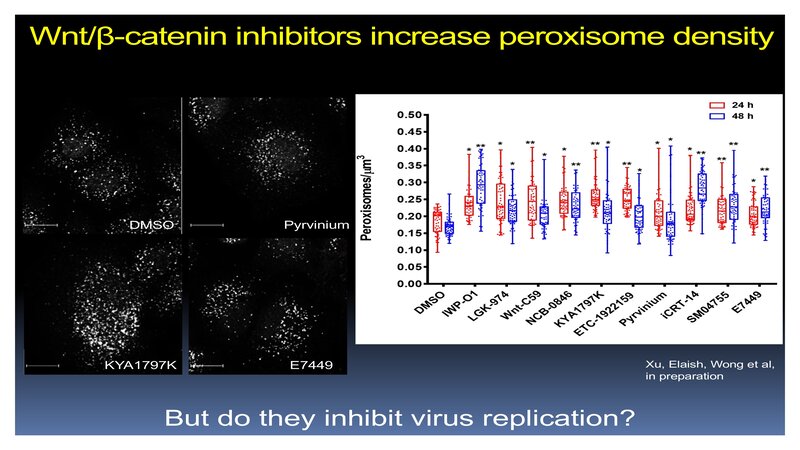
Wnt/β-catenin inhibitors increase peroxisome density DMSO KYA1797K Pyrvinium E7449 But do they inhibit virus replication? Xu, Elaish, Wong et al, in preparation

Wnt/β-catenin inhibitors reduce SARS-CoV-2 replication in multiple cell types Calu-3 Calu3 Calu3-human lung adenocarcinoma NHBE-normal human bronchial epithelial cells NHBE NHBE Xu, Elaish, Wong et al, in preparation
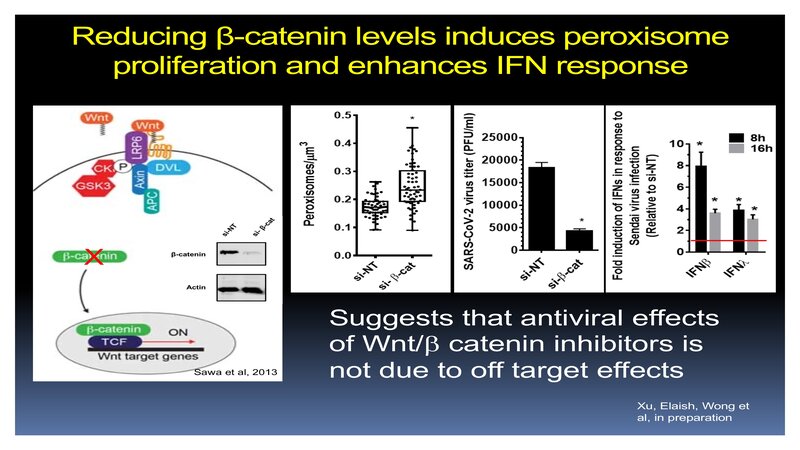
Reducing β-catenin levels induces peroxisome proliferation and enhances IFN response X Sawa et al, 2013 Suggests 38that antiviral effects of Wnt/b catenin inhibitors is not due to off target effects Xu, Elaish, Wong et al, in preparation
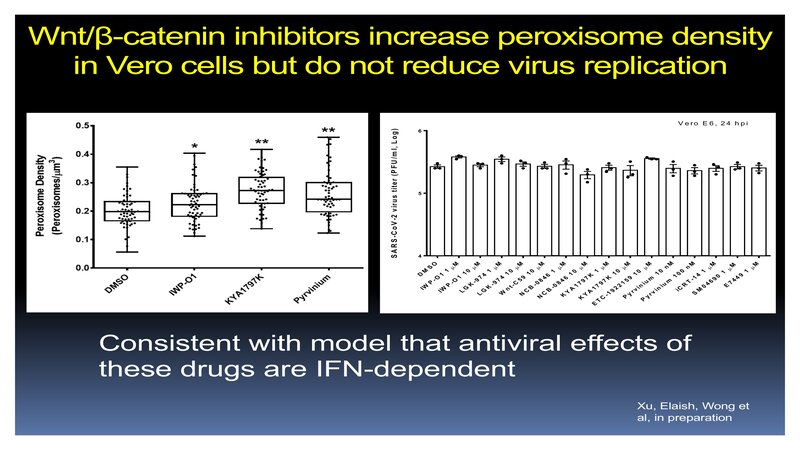
Wnt/β-catenin inhibitors increase peroxisome density in Vero cells but do not reduce virus replication 5 µM 1 µM 4 0 4 7 4 0 P y S M E 6 9 -1 T R iC 9 1 1 4 0 1 m in iu iu in rv µM n 0 0 1 0 m 1 9 5 1 2 rv y P M M n µM µM µM 0 2 9 1 E T K C Y -1 A A Y K 1 K 7 7 1 9 7 8 9 4 7 6 K 1 0 1 µM µM µM 1 6 -0 B B N C C N n t- -0 C 8 5 4 9 1 1 0 0 µM µM 1 4 W K L L G P K -9 7 -9 -O 7 1 4 1 0 1 1 IW G S M D -O P IW µM µM 4 O S A R S - C o V - 2 v ir u s tit e r ( P F U /m l, L o g ) V e ro E 6 , 2 4 h p i 6 Consistent with model that antiviral effects of these drugs are IFN-dependent Xu, Elaish, Wong et al, in preparation
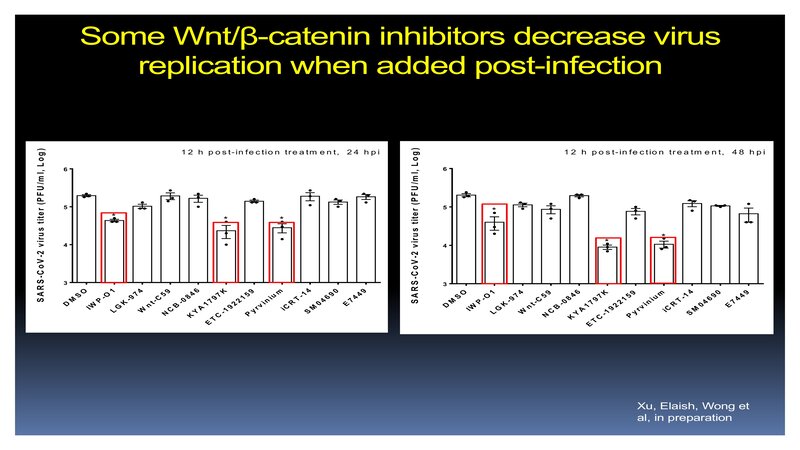
T S M 2 E 0 7 9 K 4 4 9 -1 6 6 9 4 9 0 4 m 5 7 iu 1 9 T 4 R in 2 rv 9 7 4 5 7 1 O * iC y -1 9 0 4 P C 8 C -0 t- 1 B A C Y N n -O S -9 P M K 4 9 5 W G 4 6 4 3 L 7 4 -1 4 S A R S - C o V - 2 v ir u s t it e r ( P F U /m l, L o g ) E 0 T * D M R 9 K 6 m 5 7 iu 1 9 4 5 IW S 2 in 2 rv 9 7 8 9 * iC y -1 1 -0 5 * P C A B C 6 K T Y C 4 1 2 h p o s t- in fe c tio n tr e a tm e n t, 2 4 h p i E E K N t- 1 O 7 -O S -9 P M K n G W L IW D S A R S - C o V - 2 v ir u s t it e r ( P F U /m l, L o g ) Some Wnt/β-catenin inhibitors decrease virus replication when added post-infection 1 2 h p o s t- in fe c tio n tr e a tm e n t, 4 8 h p i 6 * * 3 Xu, Elaish, Wong et al, in preparation

Drugs with high SIs chosen for testing against Variants of Concern and small animal studies E7449 KYA1797K IWP-01 Yamaguchi et al, 2020
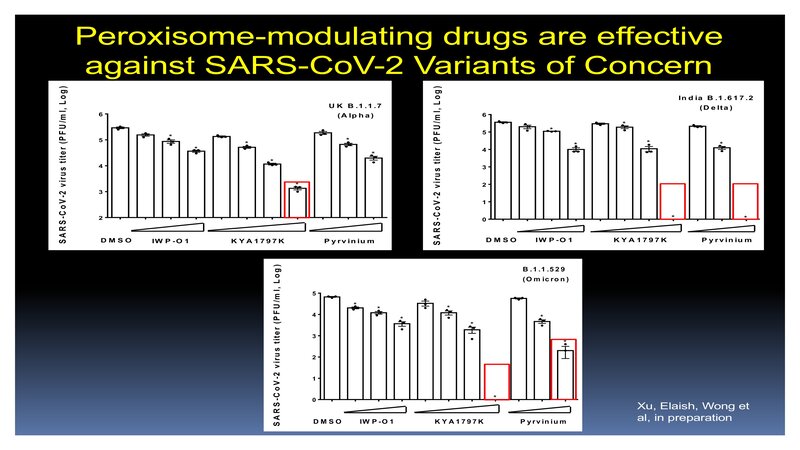
S A R S - C o V - 2 v i r u s t it e r ( P F U / m l , L o g ) U K B .1 .1 .7 6 5 (A lp h a ) * * * * * * 4 * 3 2 DMSO IW P - O 1 K YA 1797K S A R S -C o V -2 v ir u s tite r (P F U /m l, L o g ) S A R S - C o V - 2 v ir u s t it e r ( P F U /m l, L o g ) Peroxisome-modulating drugs are effective against SARS-CoV-2 Variants of Concern P y r v in iu m In d ia B .1 .6 1 7 .2 ( D e lt a ) 6 * * 5 * 4 * * 3 2 1 * 0 DMSO IW P - O 1 K YA 1797K * P y r v in iu m B .1 .1 .5 2 9 (O m ic ro n ) 5 * 4 * * * * * 3 * 2 1 * 0 DMSO IW P -O 1 K YA 1797K P y r v in iu m Xu, Elaish, Wong et al, in preparation
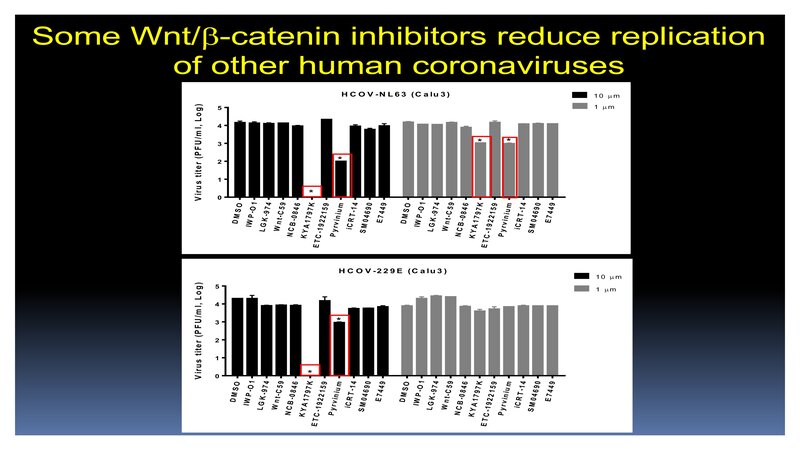
-0 8 4 6 KYA1 797K ETC1922 159 P y rv in iu m iC R T -1 4 SM 04 690 E744 9 NCB 974 W n tC59 LGK- 0 DMS O IW P O1 3 * 9 3 E744 974 W n tC59 NCB -0 8 4 6 KYA1 797K ETC1922 159 P y rv in iu m iC R T -1 4 SM 04 690 LGK- 9 DMS O IW P O1 E744 0 9 NCB -0 8 4 6 KYA1 797K ETC1922 159 P y rv in iu m iC R T -1 4 SM 04 690 O IW P O1 LGK974 W n tC59 DMS V ir u s t it e r ( P F U /m l, L o g ) 2 E744 -0 8 4 6 KYA1 797K ETC1922 159 P y rv in iu m iC R T -1 4 SM 04 690 NCB 974 W n tC59 LGK- DMS O IW P O1 V ir u s t it e r ( P F U /m l, L o g ) Some Wnt/b-catenin inhibitors reduce replication of other human coronaviruses H C O V - N L 6 3 ( C a lu 3 ) 10 µm 5 1 µm 4 * * 1 * H C O V - 2 2 9 E ( C a lu 3 ) 10 µm 5 1 µm 4 * 2 1 *
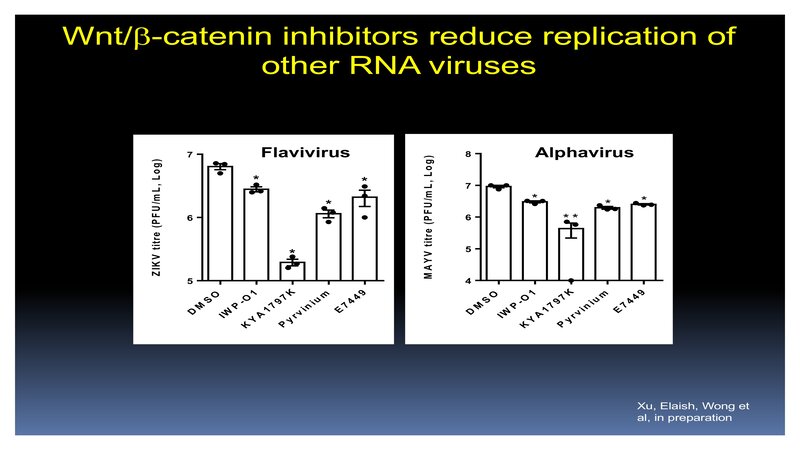
5 9 7 y E in rv 4 iu 4 m K 7 9 7 1 A P S D M 4 7 1 O 9 4 4 m in rv P y A Y K E 9 7 1 P IW iu 7 1 -O O S M K 5 ** -O * * * 6 Y 6 * P * 7 K * Alphavirus 8 IW * M A Y V t itr e ( P F U /m L , L o g ) Flavivirus 7 D Z IK V titr e (P F U /m L , L o g ) Wnt/b-catenin inhibitors reduce replication of other RNA viruses Xu, Elaish, Wong et al, in preparation
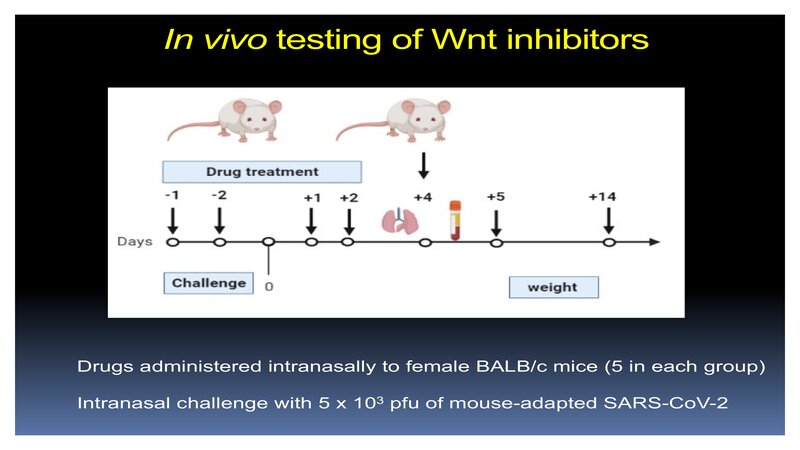
In vivo testing of Wnt inhibitors Drugs administered intranasally to female BALB/c mice (5 in each group) Intranasal challenge with 5 x 103 pfu of mouse-adapted SARS-CoV-2
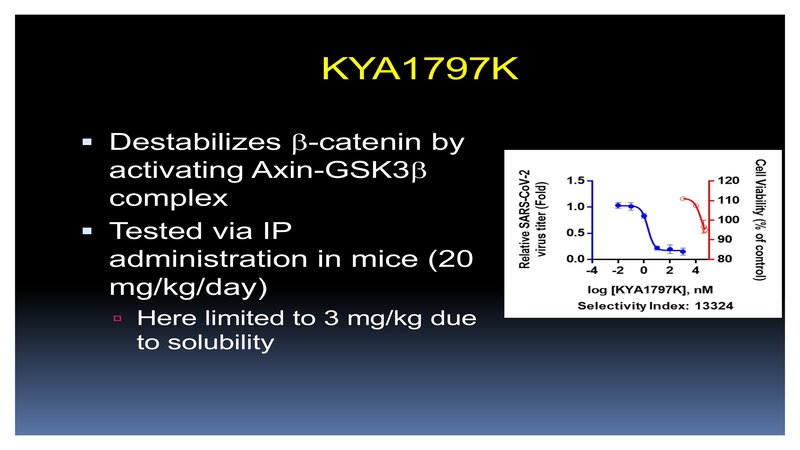
KYA1797K § Destabilizes b-catenin by activating Axin-GSK3b complex § Tested via IP administration in mice (20 mg/kg/day) ú Here limited to 3 mg/kg due to solubility
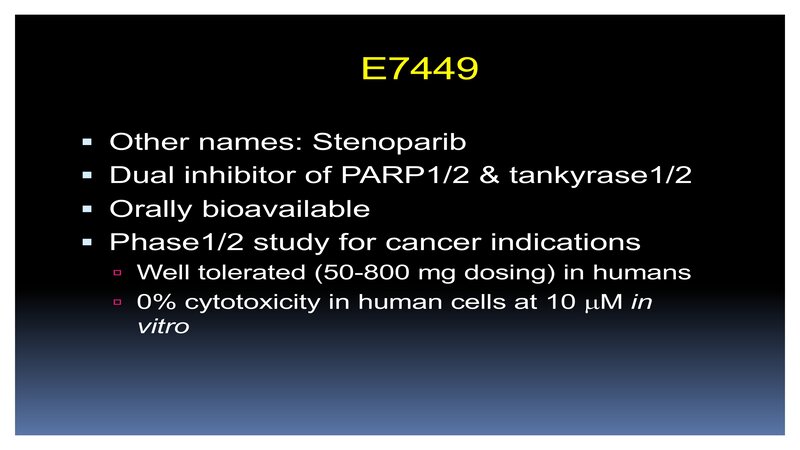
E7449 § Other names: Stenoparib § Dual inhibitor of PARP1/2 & tankyrase1/2 § Orally bioavailable § Phase1/2 study for cancer indications ú Well tolerated (50-800 mg dosing) in humans ú 0% cytotoxicity in human cells at 10 µM in vitro
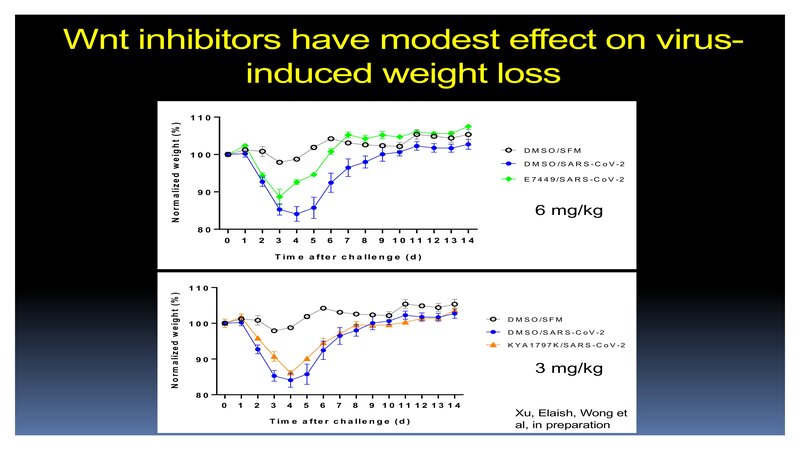
Wnt inhibitors have modest effect on virusinduced weight loss N o r m a liz e d w e ig h t ( % ) 110 D M S O /S F M 100 D M S O /S A R S - C o V -2 E 7 4 4 9 /S A R S - C o V -2 90 6 mg/kg 80 0 1 2 3 4 5 6 7 8 9 10 11 12 13 14 T im e a f t e r c h a ll e n g e ( d ) N o r m a liz e d w e ig h t ( % ) 110 D M S O /S F M 100 D M S O /S A R S - C o V -2 K Y A 1 7 9 7 K /S A R S - C o V -2 90 3 mg/kg 80 0 1 2 3 4 5 6 7 8 9 10 11 12 13 14 T im e a f t e r c h a ll e n g e ( d ) Xu, Elaish, Wong et al, in preparation

Anesthesia/IN drug administration causes mild transient weight loss N o r m a liz e d w e ig h t ( % ) 110 D M S O /S F M K Y A 1 7 9 7 K /S F M 105 E 7 4 4 9 /S F M 100 95 90 0 1 2 3 4 5 6 7 8 9 10 11 12 13 14 T im e a f t e r c h a ll e n g e ( d )

Wnt inhibitors reduce viral load in lungs PMP70 Nucleocapsid ** *** 6 5 4 Uninfected DMSO 9 44 E7 K YA 17 M 97 K SO 3 D SARS-CoV-2 titer (PFU/g tissue, Log) 4 DPI, Lung, N=5 Xu, Elaish, Wong et al, in preparation E7449 KYA1797K
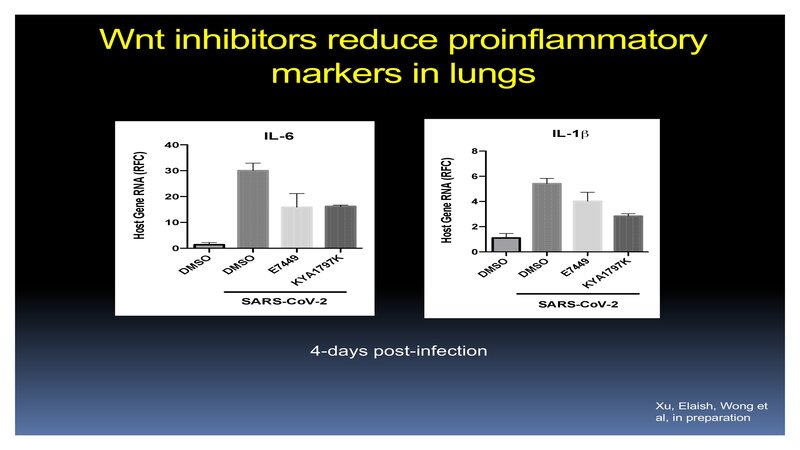
Wnt inhibitors reduce proinflammatory markers in lungs 40 Host Gene RNA (RFC) 8 30 20 10 0 6 4 2 SARS-CoV-2 K Y A 17 97 K E7 44 9 O D M S O S M D K Y A 17 97 K E 74 49 O S M D M S O 0 D Host Gene RNA (RFC) IL-1β IL-6 SARS-CoV-2 4-days post-infection Xu, Elaish, Wong et al, in preparation
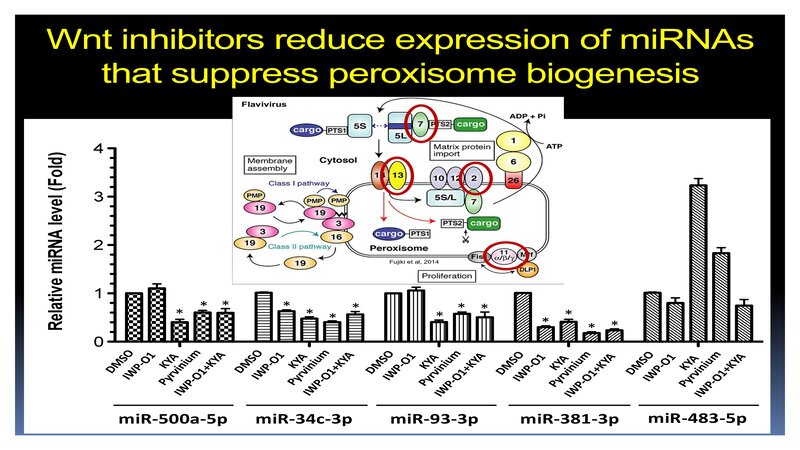
Wnt inhibitors reduce expression of miRNAs suppress peroxisome Wntthat inhibitors suppress expression biogenesis of PEX-targeting miRNAs (No infection)biogenesis HIV-1 Vpu suppresses peroxisome 4 3 2 Fujiki et al, 2014 1 * * * * * * * * * * D miR-500a-5p miR-34c-3p * * * * DM S m IWP O iR -O -9 1 Py K3Y-3 IW rvin Ap iu PO1 m +K YA DM m IW SO iR P -3 -O1 8 Py K1Y-3 IW rvin Ap iu PO1 m +K YA DM m IW SO iR P -4 -O1 8 Py K3Y-5 IW rvin Ap iu PO1 m +K YA iu PO1 m +K YA DM m IW SO iR P-3 O1 Py 4cK-Y 3 IW rvin Ap iu PO1 m +K YA 0 m I MSO iR W -5 P-O 00 1 Py aK-Y 5 IW rvin Ap Relative miRNA level (Fold) Flavivirus miR-93-3p Kristina Hopfensperger, and Daniel Sauter mBio 2020; doi:10.1128/mBio.00967-20 miR-381-3p miR-483-5p
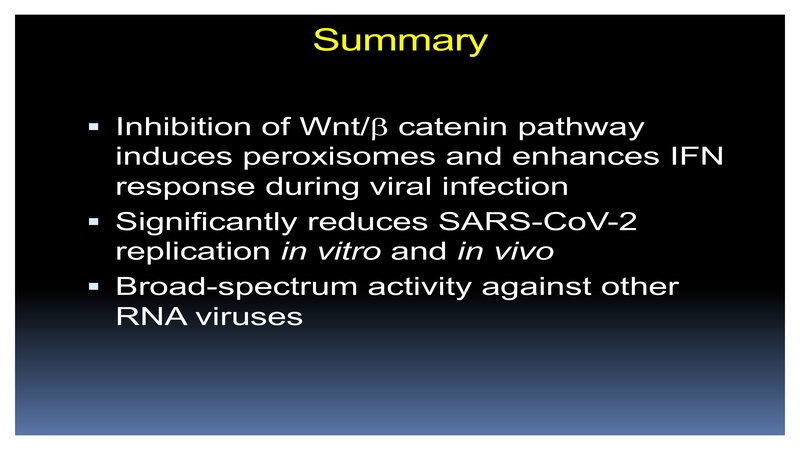
Summary § Inhibition of Wnt/b catenin pathway induces peroxisomes and enhances IFN response during viral infection § Significantly reduces SARS-CoV-2 replication in vitro and in vivo § Broad-spectrum activity against other RNA viruses
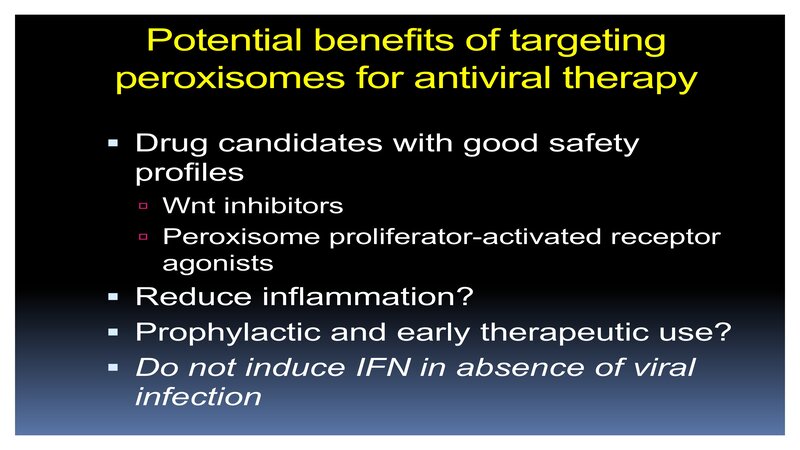
Potential benefits of targeting peroxisomes for antiviral therapy § Drug candidates with good safety profiles ú Wnt inhibitors ú Peroxisome proliferator-activated receptor agonists § Reduce inflammation? § Prophylactic and early therapeutic use? § Do not induce IFN in absence of viral infection
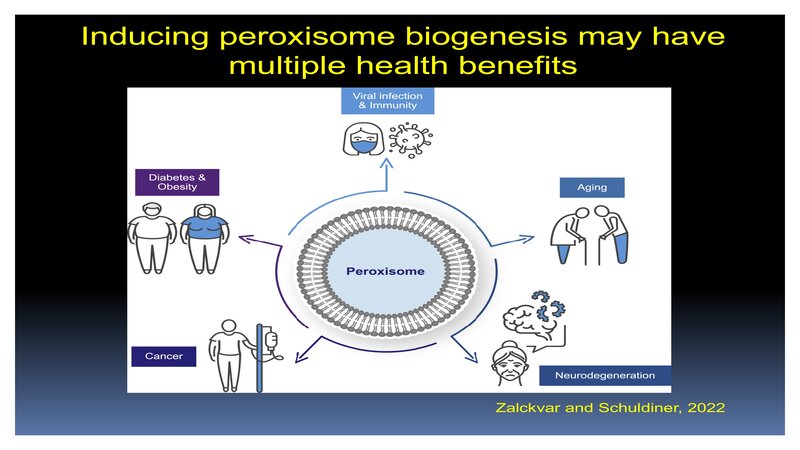
Inducing peroxisome biogenesis may have multiple health benefits Zalckvar and Schuldiner, 2022
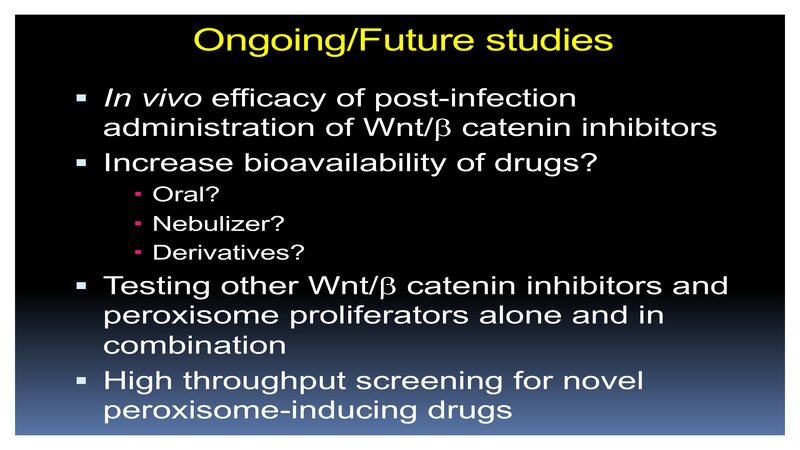
Ongoing/Future studies § In vivo efficacy of post-infection administration of Wnt/b catenin inhibitors § Increase bioavailability of drugs? Oral? Nebulizer? Derivatives? § Testing other Wnt/b catenin inhibitors and peroxisome proliferators alone and in combination § High throughput screening for novel peroxisome-inducing drugs

Acknowledgements Dr. Zaikun Xu Dr. Mohamed Elaish Dr. Jason Wong Wil Branton Dr. Natacha Ogando Dr. David Evans Dr. Chris Power Ray Ishida Dr. Rick Rachubinski Dr. Barbara Knoblach Dr. Joaquin Lopez Orozco Dr. Lara Mahal Dr. Irv Mayers Dr. Ryan Noyce